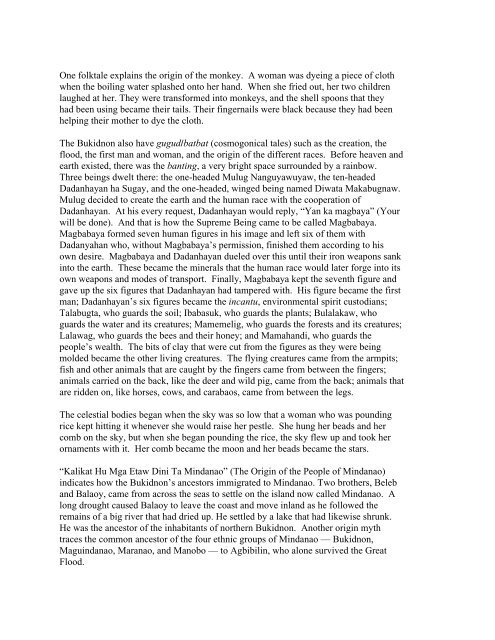Create successful ePaper yourself
Turn your PDF publications into a flip-book with our unique Google optimized e-Paper software.
One folktale explains the origin of the monkey. A woman was dyeing a piece of cloth<br />
when the boiling water splashed onto her hand. When she fried out, her two children<br />
laughed at her. They were transformed into monkeys, and the shell spoons that they<br />
had been using became their tails. Their fingernails were black because they had been<br />
helping their mother to dye the cloth.<br />
The <strong>Bukidnon</strong> also have gugud/batbat (cosmogonical tales) such as the creation, the<br />
flood, the first man and woman, and the origin of the different races. Before heaven and<br />
earth existed, there was the banting, a very bright space surrounded by a rainbow.<br />
Three beings dwelt there: the one-headed Mulug Nanguyawuyaw, the ten-headed<br />
Dadanhayan ha Sugay, and the one-headed, winged being named Diwata Makabugnaw.<br />
Mulug decided to create the earth and the human race with the cooperation of<br />
Dadanhayan. At his every request, Dadanhayan would reply, “Yan ka magbaya” (Your<br />
will be done). And that is how the Supreme Being came to be called Magbabaya.<br />
Magbabaya formed seven human figures in his image and left six of them with<br />
Dadanyahan who, without Magbabaya’s permission, finished them according to his<br />
own desire. Magbabaya and Dadanhayan dueled over this until their iron weapons sank<br />
into the earth. These became the minerals that the human race would later forge into its<br />
own weapons and modes of transport. Finally, Magbabaya kept the seventh figure and<br />
gave up the six figures that Dadanhayan had tampered with. His figure became the first<br />
man; Dadanhayan’s six figures became the incantu, environmental spirit custodians;<br />
Talabugta, who guards the soil; Ibabasuk, who guards the plants; Bulalakaw, who<br />
guards the water and its creatures; Mamemelig, who guards the forests and its creatures;<br />
Lalawag, who guards the bees and their honey; and Mamahandi, who guards the<br />
people’s wealth. The bits of clay that were cut from the figures as they were being<br />
molded became the other living creatures. The flying creatures came from the armpits;<br />
fish and other animals that are caught by the fingers came from between the fingers;<br />
animals carried on the back, like the deer and wild pig, came from the back; animals that<br />
are ridden on, like horses, cows, and carabaos, came from between the legs.<br />
The celestial bodies began when the sky was so low that a woman who was pounding<br />
rice kept hitting it whenever she would raise her pestle. She hung her beads and her<br />
comb on the sky, but when she began pounding the rice, the sky flew up and took her<br />
ornaments with it. Her comb became the moon and her beads became the stars.<br />
“Kalikat Hu Mga Etaw Dini Ta Mindanao” (The Origin of the People of Mindanao)<br />
indicates how the <strong>Bukidnon</strong>’s ancestors immigrated to Mindanao. Two brothers, Beleb<br />
and Balaoy, came from across the seas to settle on the island now called Mindanao. A<br />
long drought caused Balaoy to leave the coast and move inland as he followed the<br />
remains of a big river that had dried up. He settled by a lake that had likewise shrunk.<br />
He was the ancestor of the inhabitants of northern <strong>Bukidnon</strong>. Another origin myth<br />
traces the common ancestor of the four ethnic groups of Mindanao — <strong>Bukidnon</strong>,<br />
Maguindanao, Maranao, and Manobo — to Agbibilin, who alone survived the Great<br />
Flood.
















